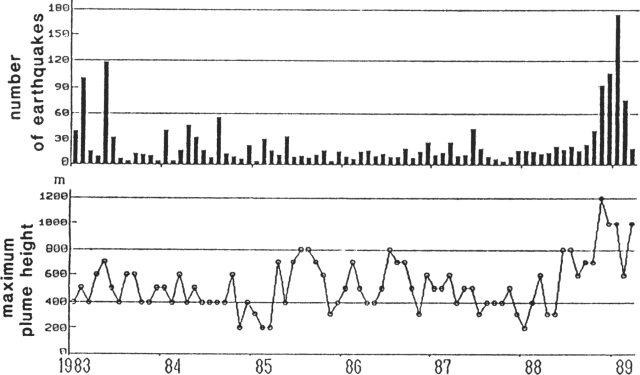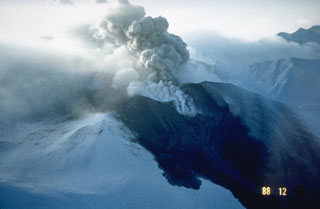Report on Tokachidake (Japan) — March 1989
Scientific Event Alert Network Bulletin, vol. 14, no. 3 (March 1989)
Managing Editor: Lindsay McClelland.
Tokachidake (Japan) Continuous steam emission; decreased seismicity
Please cite this report as:
Global Volcanism Program, 1989. Report on Tokachidake (Japan) (McClelland, L., ed.). Scientific Event Alert Network Bulletin, 14:3. Smithsonian Institution. https://doi.org/10.5479/si.GVP.SEAN198903-285050
Tokachidake
Japan
43.418°N, 142.686°E; summit elev. 2077 m
All times are local (unless otherwise noted)
Activity continued to decrease in March. Since the brief 5 March explosion (14:02) no explosions have been observed and seismicity has been low (figure 4). The steam plume reached a maximum height of 1,000 m above the rim of 62-2 Crater at 1300 on the 28th. An earthquake swarm that began 14 January . . . declined during March.
 |
Figure 4. Monthly number of earthquakes at Tokachi-dake (top) and maximum monthly plume heights (bottom), January 1983-March 1989. Courtesy of JMA. |
Geological Summary. Tokachidake volcano consists of a group of dominantly andesitic stratovolcanoes and lava domes arranged on a NE-SW line above a plateau of welded Pleistocene tuffs in central Hokkaido. Numerous explosion craters and cinder cones are located on the upper flanks of the small stratovolcanoes, with the youngest Holocene centers located at the NW end of the chain. Frequent historical eruptions, consisting mostly of mild-to-moderate phreatic explosions, have been recorded since the mid-19th century. Two larger eruptions occurred in 1926 and 1962. Partial cone collapse of the western flank during the 1926 eruption produced a disastrous debris avalanche and mudflow.
Information Contacts: JMA.

